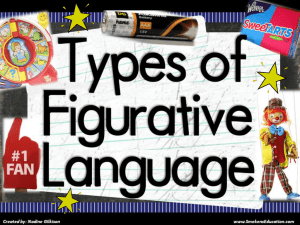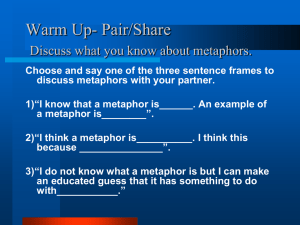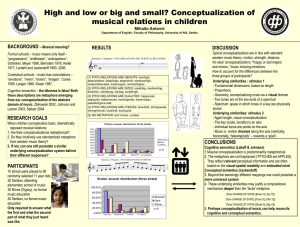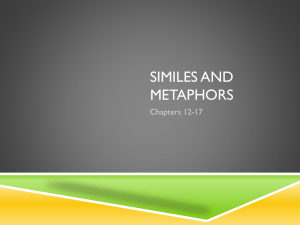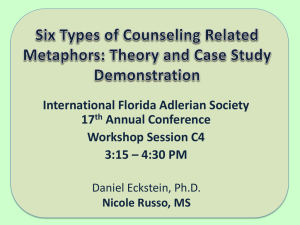Metaphor - Atkintek
advertisement
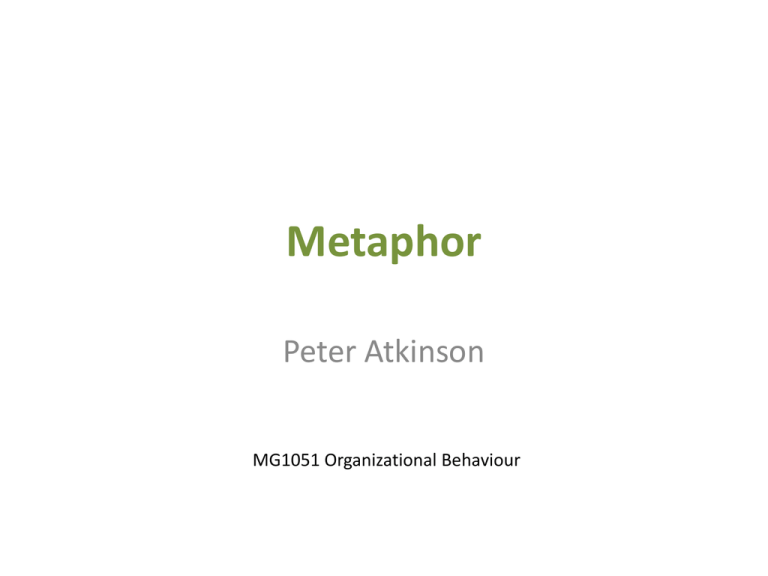
Metaphor Peter Atkinson MG1051 Organizational Behaviour Today’s Lecture • Why Metaphor? • How Metaphor Works • Using Metaphor for understanding organisations • Exercise Why Metaphor? • We think in metaphors, often without realising it • Metaphors are integral to language • Finding metaphors in what people say tells us how they think • Using metaphors in what we say reinforces our message Things Like Metaphors • Metaphor: a figure of speech that describes a subject by asserting that it is, on some point of comparison, the same as another otherwise unrelated object. – All the world’s a stage • I. A. Richards - metaphor has two parts: the tenor and the vehicle – World = tenor – Stage = vehicle • Similie: It’s like banging your head against a wall! • Metonymy: something is called by the name of something associated with it rather than by its own name – American film industry = Hollywood Thinking in Metaphors • Why did I break up with my boyfriend? Well, the relationship wasn’t going anywhere. • New York City is a zoo! • My room mate is a caveman. • My last school was a sausage machine. • Being a student at Brunel is like being given a bowl of cherries Other Side of Metaphor • When you use a metaphor you are proposing a simplified view • This simplification allows you to focus on the aspect which you want to emphasise • By doing so you exclude other aspects which may be there in reality How Metaphor Works 1 • My car is a garden shed! • My car is like a garden shed because: – It often fails to move – It is roughly assembled – It doesn’t have any engineering sophistication – It was cheap to buy How Metaphor Works 2 • My car is a garden shed! • My car is not like a garden shed because: – It is a vehicle not a building – It has wheels not foundations – It is made of metal not wood Dead Metaphors • In my examination I had to write an essay about the importance of milestones in project management. • In – examination is a container • Examination - inspection • Essay - attempt • Milestone – stones laid out at one mile intervals along a road • Project – throw forward • Management – handling, especially horses Conceptual Metaphors • Metaphors that work on you unconsciously: – – – – – – – – – – “Studying for my test tomorrow is draining” Brain = a tank or reservoir “Inflation is bad for our economy” Expanding in size = value of money decreasing “She is in danger” Danger = a place “He had a breakdown” Mind = machine ”The experience was shattering”/”He’s cracking up” Mind = brittle object Common Conceptual Metaphors • State = container “I was in a panic” • Time = moving object “I just want to get through the next hour” • • • • Communication = conduit “I couldn’t get through to him” Activity = substance “Studying is hard” Argument = war “Whatever I say, I can’t win” Theory = building “What foundation do you have for saying that?” • Relationship = journey “I get along with my boss” Spatial Metaphors • The car is in front of the tree Ups and Downs • Unconscious use of spatial metaphors: – – – – – – – – Happy is Up – Sad is Down Conscious is Up – Unconscious is Down Health and Life are Up – Sickness and Death are Down Having control is Up – Being subject to control is Down More is Up – Less is Down High status is Up – Low status is Down Good is Up – Bad is Down Rational is Up – Emotional is Down Organizational Metaphors • “I have built this business from the bottom up and I have built it on firm foundations. The trouble is I can’t get it to move forwards!” • “By the end of this campaign we should have increased our market share. Our target is 50% of the UK market.” • Human Resources • Apple (brand name) Morgan’s 8 Organisational Metaphors http://www.ribbonfarm.com/2010/07/13/the-eight-metaphors-of-organization/ Using Metaphor - example • Consultant looking at a business that needed fundamental (transformational) change not a little amount, a step-at-a-time (developmental) change • “What the manager really wanted was for people to leave behind the old ways, and to reinvent the organization. But he kept talking to them about building upon past successes, and exhorting them to greater efforts at further development. The change metaphors he was using with his staff were inconsistent with the type of change he was trying to implement”. • His diagnosis was for the manager to align his language, and his metaphors in use, with the type of change he wished to achieve. • Akin and Palmer (2000) “Putting Metaphors to Work for Change in Organizations”. Using Metaphor • Group exercises: • Think of an organisation you are all familiar with eg. London Transport, NHS, Brunel University… • What metaphor could you use to describe it? – give at least 3 examples of how your metaphor helps to understand it • If you wanted to improve your organisation, what metaphor would you use to describe how you would like it to be? - give at least 3 examples of how the metaphor would help you to change it Concluding • What have we learned about metaphor? – Vehicle + Tenor – Can work unconsciously – Language is inherently metaphorical so that, for example, we don’t even notice when we use the body metaphor – Metaphors tell us how people are thinking – Metaphors help to change people’s minds References • Further Reading – G Lakoff and M Johnson (1980) Metaphors We Live By, Chicago: University of Chicago Press. – G Morgan (2006) Images of Organization, Thousand Oaks, Ca.: Sage. – G Morgan (1981) The Schismatic Metaphor and Its Implications for Organizational Analysis, Organization Studies, 2. – H Oztel and O Hinz (2001) Changing Organizations with Metaphors, The Learning Organization, 8. – Y Gabriel (2006) Myths, Stories and Organizations, Oxford: OUP. – Y Gabriel (2000) Storytelling in Organizations: Facts, Fictions and Fantasies, Oxford: OUP.


